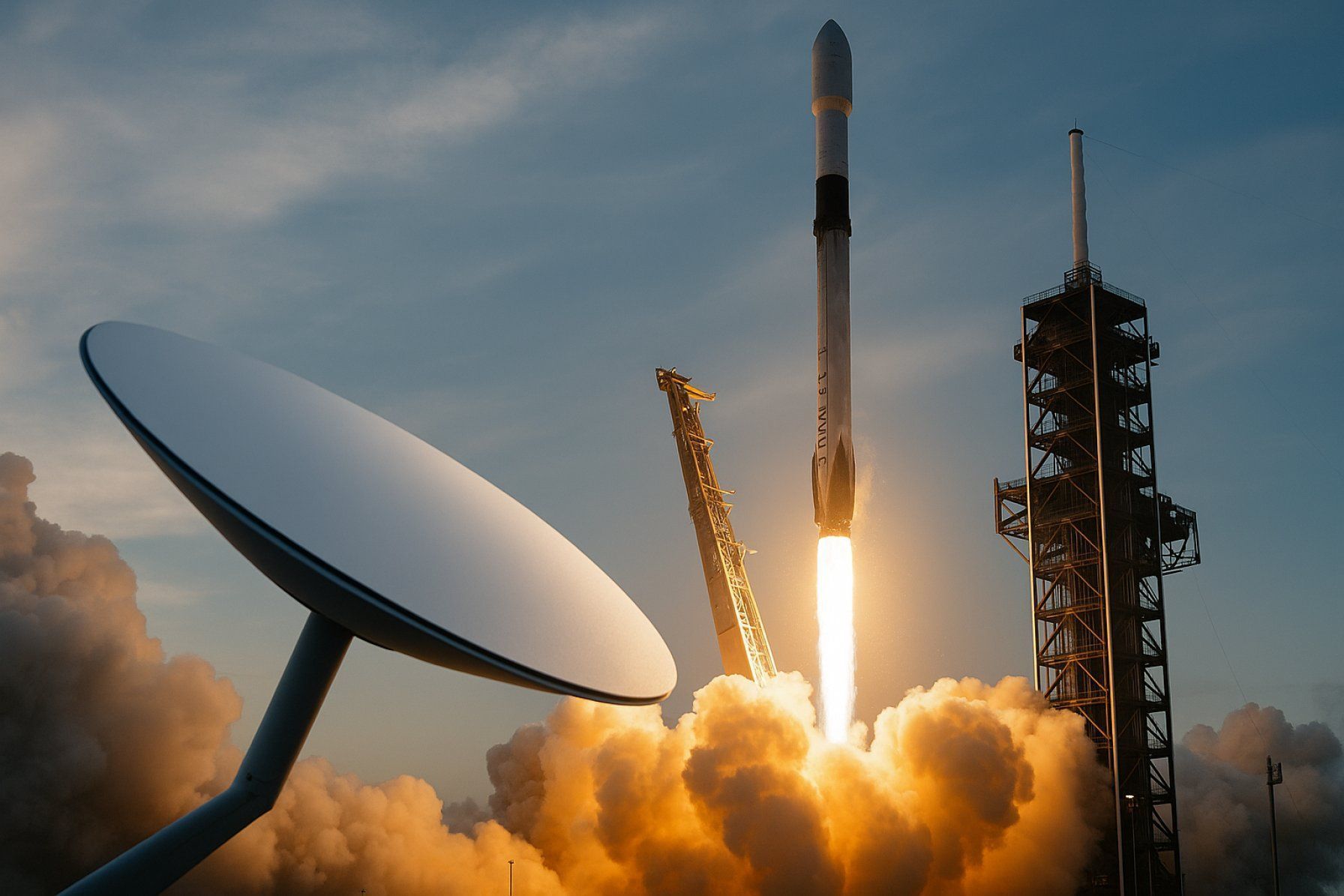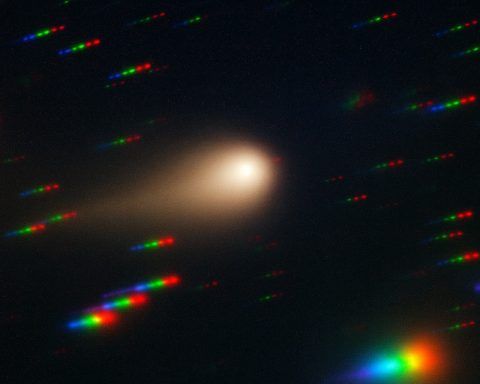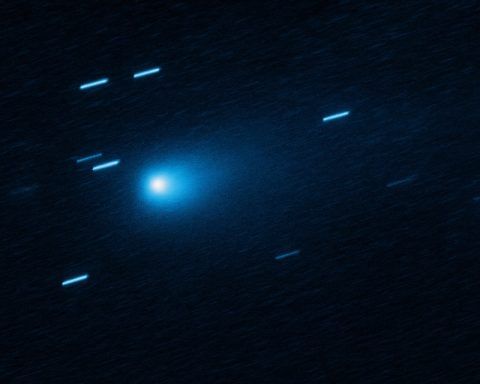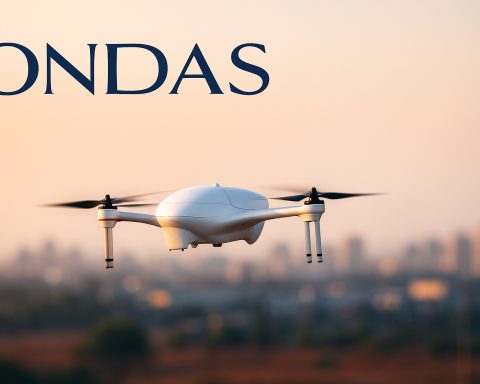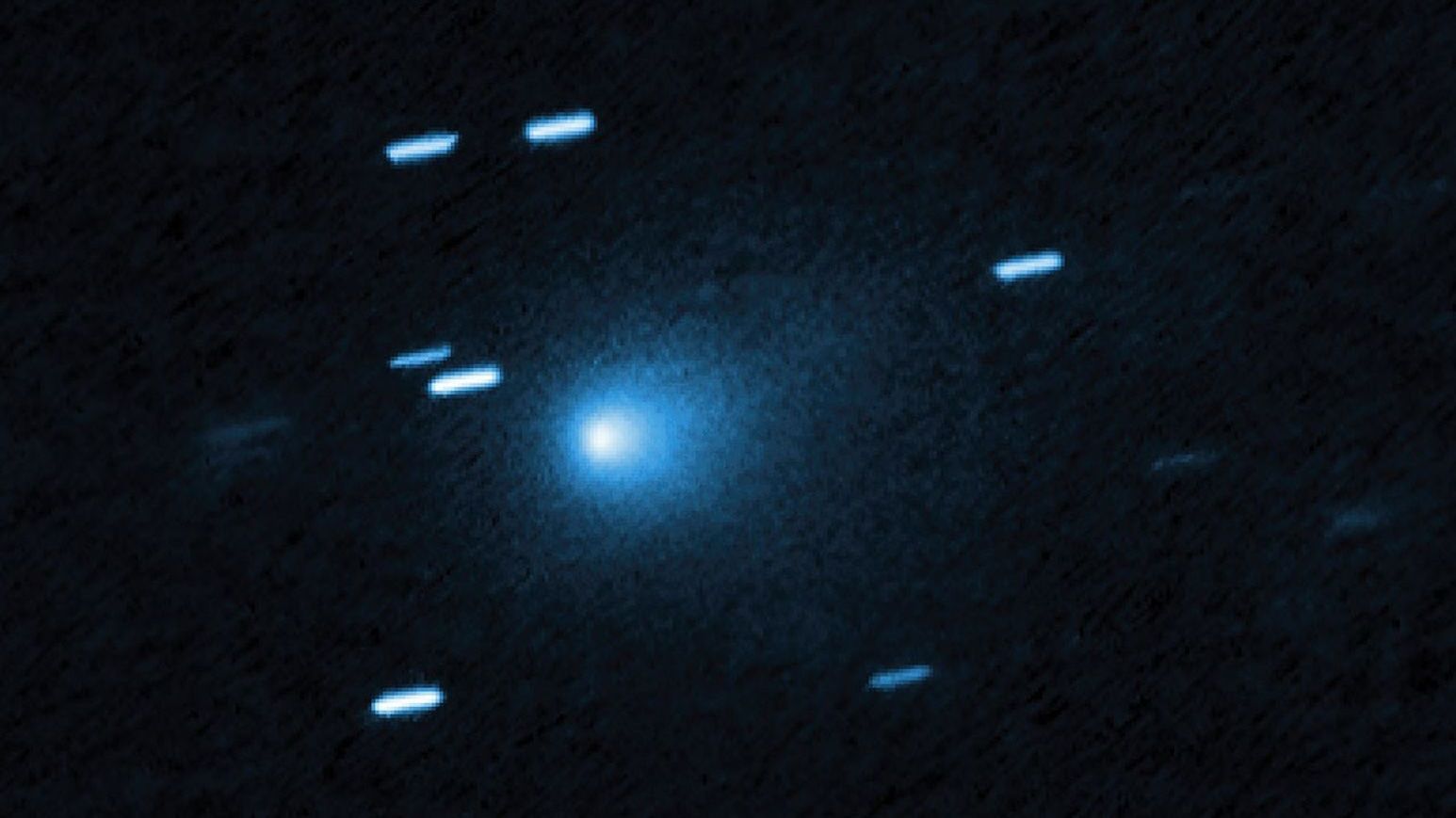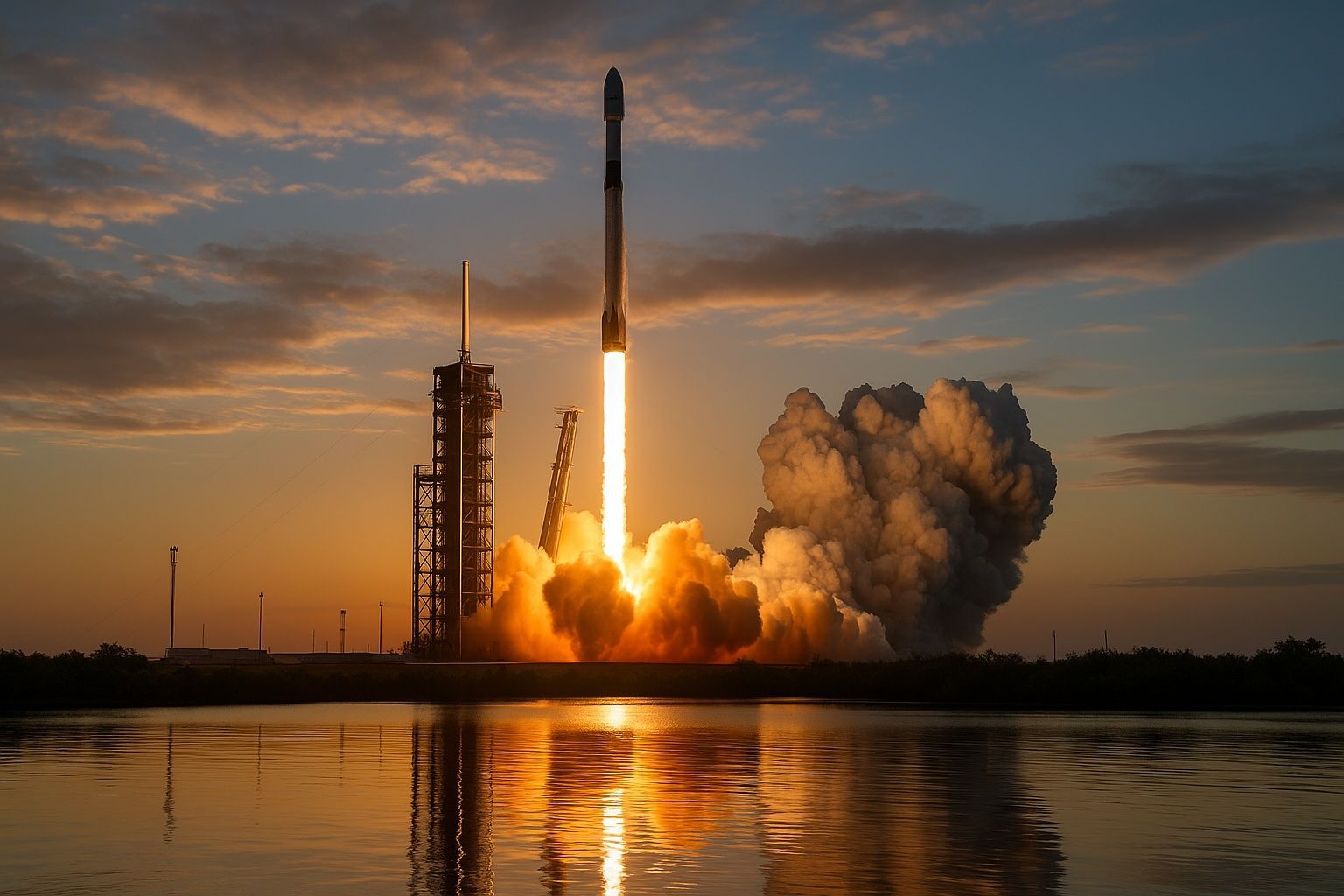- NASA announced live space coverage on Netflix in 2025, following the launch of NASA+ on Amazon Prime.
- From July 2025, Starlink Direct to Cell, launched with T-Mobile, will let smartphones connect directly to Starlink satellites for calls and messages, backed by 657 Starlink V3 satellites.
- Starlink received regulatory clearance to deliver satellite internet to rural India, bridging the digital divide amid Elon Musk’s expanding political influence.
- Eutelsat achieved the world’s first successful 5G mobile connection via satellite through the IRIS2 program, enabling 5G on standard smartphones.
- SpaceX’s first GTO mission will carry Israel’s Dror-1 geostationary satellite from Cape Canaveral on a Falcon 9, with a booster landing on a drone ship in the Atlantic.
- SpaceX seeks new funding at a $400 billion valuation, up from $350 billion in December 2024, while battling a lawsuit with the California Coastal Commission.
- The Ax-4 mission on the ISS, led by Peggy Whitson, lasted 17 days and conducted over 60 experiments and 20 outreach events.
- Indian astronaut Shubhanshu Shukla completed four of seven ISRO-led microgravity experiments aboard the ISS, including diabetes research.
- MethaneSAT, launched by SpaceX to monitor industrial methane emissions, lost contact and is presumed inoperable, but provided high-precision climate data.
- ESA’s Biomass satellite, launched in April 2024, uses P-band radar to map global carbon stocks in 3D, enabling tracking of deforestation and polar ice melt.
The New Golden Age of Space: Streaming, Satellites, and Superpowers
The 2020s are rapidly becoming a new golden age for space exploration and technology. From the democratization of space access through streaming platforms to the militarization of orbits and the rise of eco-friendly satellites, today’s headlines reveal a world where space is no longer the exclusive domain of governments and scientists. Instead, it’s a battleground for tech giants, a laboratory for climate solutions, a classroom for the next generation, and—perhaps most importantly—a critical front in global security and geopolitics.This comprehensive review of today’s space news captures the breadth and depth of the modern space revolution, highlighting the key players, missions, and trends that are shaping our collective future beyond Earth.Space Goes Mainstream: NASA, Netflix, and the Streaming Revolution
NASA Partners with Netflix for Live Space Coverage
NASA’s push to bring space closer to the public has taken a giant leap: live coverage of rocket launches, spacewalks, and other cosmic events will soon be available on Netflix. This move follows the recent launch of NASA+ on Amazon Prime, signaling a new era where space exploration is as accessible as your favorite TV show.“Live space coverage now offered on NASA+…will also be coming to Netflix soon this summer,” the agencies confirmed.
Key Takeaways
- Space for all: NASA’s partnership with Netflix and Amazon Prime brings launches and science to millions of living rooms.
- Public engagement: This strategy aims to inspire new generations and boost support for space programs.
- Outlook: Expect more immersive, interactive, and educational space content as streaming platforms compete for cosmic audiences.
Starlink, Direct-to-Cell, and the Satellite Internet Revolution
Starlink Direct to Cell: Eliminating Dead Zones
Elon Musk’s Starlink is set to revolutionize mobile connectivity. Starting July 2025, Starlink’s Direct to Cell service—launched with T-Mobile—will allow smartphones to connect directly to satellites for calls, messages, and even optimized apps like WhatsApp and Google Maps. Over 657 Starlink V3 satellites will serve as “space-based towers,” promising global coverage and the end of terrestrial dead zones.“Developers can use Starlink’s API to adapt apps for satellite use, ensuring global coverage.”
Recap
- No more dead zones: Full app connectivity without mobile coverage.
- API for developers: Apps can be optimized for satellite use.
- Disaster resilience: Starlink texting already proved vital during New Zealand floods ( [3]).
Starlink Secures Indian License Amid Political Moves
Starlink’s expansion into India marks a significant milestone. With regulatory clearance to deliver satellite internet to rural areas, Starlink is poised to bridge the digital divide in one of the world’s largest markets. The move coincides with Elon Musk’s growing political influence, as he launches a new party and assumes a government role.“Thank you, Mr. President, for this incredible opportunity…”
Recap
- Rural connectivity: Starlink brings high-speed internet to underserved regions.
- Political power: Musk’s dual role in tech and politics raises questions about the future of space governance.
Eutelsat’s 5G Satellite Breakthrough
Not to be outdone, Eutelsat has achieved the world’s first successful 5G mobile connection via satellite, directly supporting standard smartphones. This EU-backed IRIS² program could bring satellite-based 5G to remote regions, challenging Starlink’s dominance.“Enable the use of satellite broadband for 5G devices worldwide.”
Recap
- 5G from space: Eutelsat’s breakthrough could reshape mobile networks.
- Competition heats up: Expect a race between Starlink, Eutelsat, and China Telecom for global satellite connectivity.
China Telecom’s Direct-to-Satellite Solutions
China Telecom has launched direct-to-satellite communication services for phones, vehicles, and industry, enabling voice and SMS in remote or emergency scenarios. This marks a shift from professional to mass consumer markets, supporting tourism and emergency response.“This marks a practical new stage for China’s star-ground integrated communication technology.”
SpaceX: Launches, Lawsuits, and a $400 Billion Valuation
GTO-1: SpaceX’s Latest Falcon 9 Launch
SpaceX continues to dominate the launch market. The upcoming GTO-1 mission will see a Falcon 9 rocket carry Israel’s Dror-1 geostationary communications satellite from Cape Canaveral, with a booster landing on a drone ship in the Atlantic. This is SpaceX’s first mission named ‘GTO.’“Viewing opportunities span from Jacksonville Beach to West Palm Beach. Live coverage and updates will be provided by USA TODAY Network’s Space Team.”
Recap
- First ‘GTO’ mission: A new chapter for SpaceX’s commercial launches.
- Public engagement: Live coverage and viewing guides for the public.
SpaceX’s $400 Billion Valuation and Legal Battles
SpaceX is reportedly seeking new funding at a staggering $400 billion valuation, up from $350 billion in December 2024. The company is also embroiled in a legal battle with the California Coastal Commission, alleging regulatory retaliation due to Elon Musk’s political views.Recap
- Unprecedented valuation: SpaceX cements its position as the world’s most valuable private space company.
- Regulatory friction: Legal challenges highlight the complex intersection of space, politics, and environmental oversight.
Starbase: Elon Musk’s SpaceX City in Texas
Starbase, the city built by Elon Musk for SpaceX employees in Texas, serves as a hub for launch operations and innovation. It embodies SpaceX’s ambitious goals for space exploration and provides a dedicated community for its workforce.The Satellite Wars: Security, Espionage, and Geopolitics
France Warns of ‘Extremely Alarming’ Russian Activity in Space
French military chief Thierry Burkhard has sounded the alarm over Russian satellites used for espionage and possible militarization of space, citing specialized satellites that may violate demilitarization laws.“There are signs of a desire to militarize space.”
Russia Deploys Network of Reconnaissance Satellites
Russia is rapidly expanding its orbital reconnaissance capabilities, aiming for a constellation of at least 300 satellites. This network is seen as a step toward the militarization of space.Iran Destroys US Satellite Communications Dome in Qatar
Satellite images confirm that an Iranian missile strike destroyed a US military satellite communications dome at Al Udeid Air Base, Qatar. While the Pentagon insists the base remains operational, the attack highlights vulnerabilities in critical space infrastructure.The New Space Wars: Book Review
Frediano Finucci’s new book, “La guerre des satellites,” details how satellites have become central to military, commercial, and geopolitical conflicts, shaping the Russia-Ukraine war and Iran-Israel clashes.“Satellites are the nerve center of today’s major issues.”
Recap
- Militarization of space: Growing concerns over satellite espionage and anti-satellite weapons.
- Vulnerable infrastructure: Recent attacks and satellite deployments underscore the need for robust space security.
Climate, Agriculture, and the Eco-Satellite Revolution
Satellites Aid Sustainable Livestock Farming
A new methodology from Embrapa combines satellite imagery and agrometeorological modeling to estimate pasture forage in Brazil, supporting sustainable livestock management. The SAFER model uses data from NASA and ESA satellites.ESA Biomass Satellite: Unveiling Forest Secrets
ESA’s Biomass satellite, launched in April 2024, uses pioneering P-band radar to penetrate forests and ice, mapping global carbon stocks in 3D. This enables precise tracking of deforestation, carbon storage, and polar ice melt.Dutch Experts Develop Twin Satellites for Greenhouse Gas Monitoring
Dutch scientists are building twin satellites to pinpoint greenhouse gas emissions from space, providing precise data to support climate action and environmental policy.MethaneSAT: A Setback for Climate Monitoring
MethaneSAT, launched by SpaceX to monitor industrial methane emissions, has lost contact and is presumed inoperable. Despite its early end, the mission provided high-precision data crucial for climate research.Recap
- Satellites for sustainability: New missions are revolutionizing agriculture, forestry, and climate monitoring.
- Setbacks and promise: MethaneSAT’s loss is a blow, but the eco-satellite revolution continues.
The International Space Station: Science, Collaboration, and Inspiration
Ax-4 Mission: Science, Outreach, and International Collaboration
The Ax-4 crew, led by Commander Peggy Whitson, is wrapping up a 17-day stay on the ISS, conducting over 60 scientific experiments and 20 outreach events. Research focused on microalgae, cognitive adaptation, astronaut health, and more.Indian Astronaut Shubhanshu Shukla: Science and Cultural Diplomacy
Shubhanshu Shukla, India’s first astronaut in 40 years, has completed four of seven ISRO-led microgravity experiments aboard the ISS. His work includes diabetes research that could revolutionize healthcare on Earth, and he’s inspired a new generation of Indian stargazers.Space Food Innovation: Gajar ka Halwa in Orbit
Shukla also brought a taste of India to the ISS, sharing Gajar ka halwa (carrot pudding) with his crewmates—a culinary innovation by ISRO and DRDO that highlights the unifying power of food in space.ISS Science and Maintenance: Water Recycling and Plant Growth
Expedition 73 astronauts replaced the water reclamation system’s recycle tank, ensuring continued recycling of wastewater into drinking water. They also conducted experiments on lighting, plant growth, and muscle stimulation.Recap
- International collaboration: ISS remains a beacon of global cooperation.
- Science for Earth: Research aboard the ISS is driving advances in health, sustainability, and technology.
Space for All: Education, Inspiration, and the Next Generation
Croydon High School’s Astrogazers: All-Girls Satellite Launch
The Astrogazers team at Croydon High School successfully flight-tested their CubeSat, aiming to become the first all-girls school to launch a satellite. Their Mission Pegasus is planned for 2026–27.Jared Isaacman’s $15 Million Donation to Space Camp
Ex-astronaut Jared Isaacman has donated $15 million to the U.S. Space & Rocket Center for the Inspiration4 Skills Training Complex, supporting space education and training for the next generation.4-H Rocket Launch at Vigo County Fair
The 2025 4-H Rocket Launch showcased youth rocket-building skills, inspiring the next generation of engineers and explorers.Recap
- Diversity and inclusion: All-girls teams and global outreach are expanding access to space.
- Hands-on learning: Investments in education and youth programs are building the workforce of tomorrow.
Science Frontiers: Mars, the Moon, and Interstellar Visitors
NASA Imaging Revolutionizes Our View of Mars
From Mariner 4’s first photos in 1965 to the high-resolution panoramas of Viking, Pathfinder, and Opportunity, NASA’s imaging technology has transformed our understanding of Mars, revealing its surface, geology, and history.Mars: Water Loss and Habitability
Recent studies suggest Mars’ extreme axial tilts over the past 20 million years accelerated water loss, while a natural negative feedback loop involving carbonates removed CO₂ from the atmosphere, cooling the planet and making it uninhabitable.The Moon’s Volcanic and Geological Secrets
A Nature study reveals the Moon was once far more volcanically active than previously thought, with its crust melting multiple times due to intense tidal interactions with Earth. Meanwhile, scientists have identified over 200 previously unknown structures on the Moon’s far side, indicating geological activity as recent as 160–200 million years ago.Interstellar Object 3I/ATLAS: New Insights
A team led by Michigan State University has published the most detailed study yet on interstellar object 3I/ATLAS, only the third such visitor detected in our solar system. The rapid, international response underscores the excitement and scientific value of these rare events.Technology, Policy, and the Business of Space
SES-Intelsat Merger Approved
The FCC has approved SES’s acquisition of Intelsat, aiming to create a more vigorous satellite competitor, lower costs, improve quality, and increase investment in satellite communications.UK Government Invests in Eutelsat
The UK government has invested €163.3m in Eutelsat, retaining a 10.9% stake and supporting the satellite operator’s €1.5bn fundraising round. This move strengthens the UK’s position in the satellite sector and supports the expansion of space infrastructure.Airbus and Hisdesat Sign Paz 2 Satellite Deal
Airbus will develop two advanced PAZ-2 satellites for the Spanish Ministry of Defense, providing high-resolution radar imagery for military intelligence and civil applications.China Achieves Full Domestic Production of Broadcast Satellites
China’s successful launch of the Zhongxing-9C satellite marks full domestic production of broadcast TV satellites, with improved performance and secure satellite broadcasting.Russia Opens First Glonass Satellite Ground Station in Venezuela
Russia and Venezuela have inaugurated the first local ground station for the Glonass satellite navigation system, enhancing cooperation and improving navigation, agriculture, and telecommunications in the region.Space Science: Solar Probes, DART, and the Future of Planetary Defense
Parker Solar Probe: Closest-Ever Images of the Sun
NASA’s Parker Solar Probe has achieved a record-breaking close approach to the Sun, capturing unprecedented footage of a powerful coronal mass ejection (CME) and providing the first direct visual proof of Kelvin-Helmholtz instabilities.NASA DART Mission: Unintended Consequences
NASA’s DART mission altered Dimorphos’ orbit, but ejected boulders gained up to three times the spacecraft’s momentum, complicating planetary defense efforts. The findings suggest asteroid deflection is more complex than previously thought.The Moon, the Buck Moon, and Celestial Phenomena
Full Buck Moon in Capricorn: Spiritual and Scientific Insights
The Full Buck Moon in Capricorn on July 10th offered a time for self-reflection, breaking old patterns, and spiritual renewal. NASA confirms the next full moon, the Sturgeon Moon, occurs August 9.Space Debris, Satellite Anomalies, and the Risks of the New Space Age
Relay 2 Satellite Emits Powerful Radio Signal
Australian astronomers detected a strong radio signal from the long-defunct Relay 2 satellite, highlighting concerns about space debris and the unpredictable behavior of old satellites.Meteorologists Face Loss of Key Hurricane-Tracking Satellites
Meteorologists will soon lose access to three crucial DMSP satellites, which provide microwave imagery essential for tracking hurricane structure and intensity. This could impact forecast accuracy and preparedness.Leadership, Policy, and the Future of NASA
Sean Duffy Appointed Interim NASA Administrator
President Trump has named Sean Duffy, former Wisconsin congressman and current U.S. Transportation Secretary, as interim NASA administrator. Duffy, who lacks a scientific background, will focus on advocating for NASA in Washington.NASA Faces Budget Cuts and Leadership Changes
NASA is set to reduce its workforce and faces budget cuts, raising questions about the value of space exploration and the impact of political decisions on the agency’s future.NASA Astronaut Shannon Walker Retires
NASA astronaut Shannon Walker has retired after a distinguished 21-year career, including 330 days in orbit and leadership roles on the ISS. She was the first woman to fly aboard a Dragon spacecraft.Outlook: The Next Frontiers
What’s Next?
- Streaming space: Expect more live launches and science content on mainstream platforms.
- Satellite wars: The race for orbital dominance will intensify, with security, espionage, and resilience in focus.
- Eco-satellites: Climate and environmental monitoring will drive new missions and technologies.
- Space for all: Education, diversity, and public engagement are key to sustaining the space revolution.
- Science and exploration: Mars, the Moon, and interstellar visitors will continue to unlock secrets of our solar system and beyond.
- Policy and leadership: Political decisions and funding will shape the pace and direction of space exploration.
Bullet Recap
- NASA and Netflix: Live space coverage coming to streaming platforms.
- Starlink and Eutelsat: Satellite internet and 5G connectivity race heats up.
- SpaceX: New launches, $400B valuation, and legal battles.
- Satellite wars: Russia, China, and Iran highlight growing security concerns.
- Climate satellites: ESA Biomass, Dutch twins, and MethaneSAT drive sustainability.
- ISS science: Ax-4, Indian astronaut Shukla, and international collaboration.
- Education: All-girls satellite teams, Space Camp expansion, and youth rocket launches.
- Mars and Moon: New insights into water loss, volcanic activity, and geology.
- Space debris: Defunct satellites and loss of hurricane-tracking assets raise alarms.
- Leadership: NASA faces budget cuts, new administrator, and astronaut retirements.
Conclusion
The space sector is at a crossroads—where technology, policy, and society intersect. Today’s news reveals a world where space is no longer distant or abstract, but immediate, accessible, and deeply intertwined with our daily lives, security, and future. As the new space race accelerates, the choices we make now will shape humanity’s destiny among the stars.For further reading, visit the linked sources throughout this article for in-depth coverage of each story.
Complete List of Reference Sources
References
1. www.usatoday.com, 2. www.xatakamovil.com, 3. media.one.nz, 4. timesofindia.indiatimes.com, 5. www.tagesschau.de, 6. m.cnmo.com, 7. finance.sina.cn, 8. www.floridatoday.com, 9. www.tcpalm.com, 10. www.news-journalonline.com, 11. www.floridatoday.com, 12. finance.yahoo.com, 13. santamariatimes.com, 14. www.businessinsider.com, 15. help.hvylya.net, 16. www1.ru, 17. www.indiatoday.in, 18. en.abna24.com, 19. www.express.co.uk, 20. www.opinion-internationale.com, 21. www.poder360.com.br, 22. noticiasambientales.com, 23. noticiasambientales.com, 24. nltimes.nl, 25. www.gismeteo.ru, 26. www.axiomspace.com, 27. www.axiomspace.com, 28. www.nasa.gov, 29. timesofindia.indiatimes.com, 30. timesofindia.indiatimes.com, 31. www.theguardian.com, 32. www.indiatoday.in, 33. timesofindia.indiatimes.com, 34. www.space.com, 35. www.yourlocalguardian.co.uk, 36. www.upi.com, 37. www.al.com, 38. www.rocketcitynow.com, 39. www.tribstar.com, 40. www.nasa.gov, 41. www.livescience.com, 42. unionrayo.com, 43. www.newsinfo.ru, 44. www.newsinfo.ru, 45. thedebrief.org, 46. www.satellitetoday.com, 47. www.telcotitans.com, 48. sdarabia.com, 49. www.elmundo.es, 50. www.news.cn, 51. www.ansa.it, 52. timesofindia.indiatimes.com, 53. thedebrief.org, 54. www.refinery29.com, 55. www.usatoday.com, 56. www.yahoo.com, 57. www.cnn.com, 58. theconversation.com, 59. www.wpr.org, 60. www.theatlantic.com, 61. www.nasa.gov
